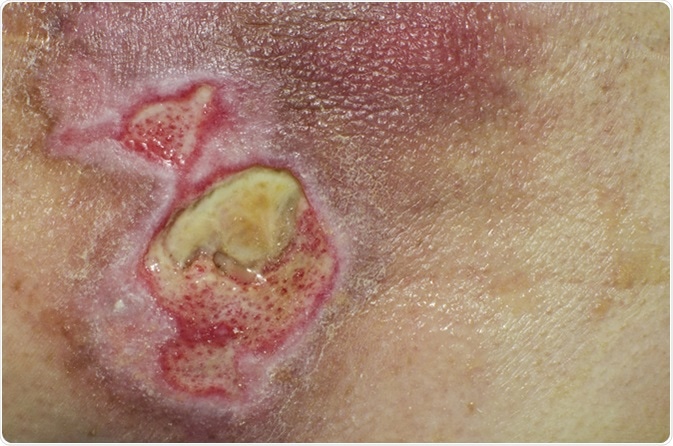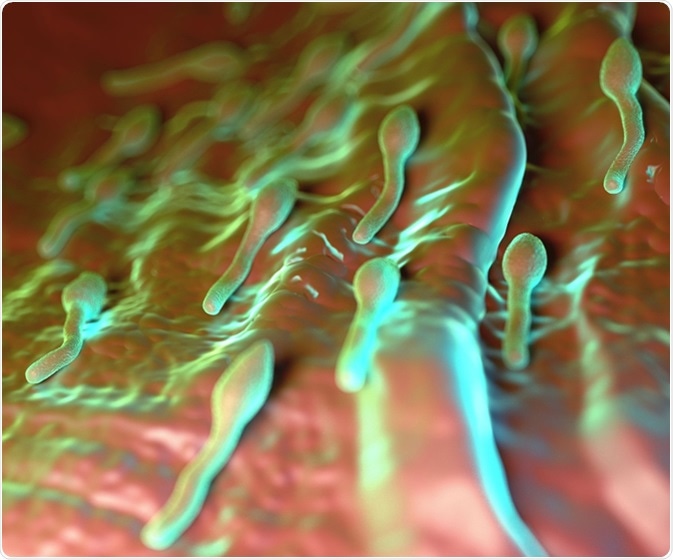
Preventing Infection in Open Wounds
Open wounds are an entry point for pathogens, and are therefore susceptible to infections. This can lead to the development of disease, so ensuring that a wound does not become infected is very important in healthcare.

Serious open wound on a skin. Image Credit: Ciolanescu / Shutterstock
How Infection is Caused
Infections occur in three steps, beginning with the colonization of a host, then disease development within a host, and finally transmission of the pathogen to another host.
Colonization occurs when an organism enters the body, in this case through an open wound. The organism can then grow and multiply within the host. Individuals that are weak, ill, or have compromised immune systems are susceptible to colonization by pathogenic organisms. The site of entry for a pathogen, the virulence of the pathogen, the quantity of the entering pathogen, and the immune status of the host affect the ability of the pathogen to infect the host.
An infection arises when the host immune system cannot get rid of the pathogen and the organism causes damage to the host. Infection with Clostridium tetani infections produces a toxin that inhibits the release of glycine and γ-aminobutyric acid (GABA) neurotransmitters from inhibitory neurons. This leads to spastic paralysis, resulting in death from exhaustion and respiratory failure. Staphylococcus aureus infections produce several toxins that can induce a variety of reactions. The release of superantigens causes toxic shock syndrome, resulting in fevers, low blood pressure, and even multiple organ failure. Panton-Valentine leucocidin (PVL) release causes lysis of white blood cells, which compromises the immune system.

3d rendering - clostridium tetani bacterium. Image Credit: royaltystockphoto.com / Shutterstock
There are many ways that pathogens are transmitted from host to host. In the case of wounds pathogens are usually transmitted via direct contact with the wound (seen in C. tetani infections), or iatrogenic transmission (due to medical procedures, as with S. aureus infections).
Sepsis
Sepsis occurs when bacteria or chemicals from the immune system make it into the bloodstream. This causes systemic inflammation throughout the entire body, resulting in many life-threatening implications.
Several microbial factors cause the ‘septic inflammatory cascade’. Pathogens are recognized by their pathogen-associated molecular patterns (PAMPs). Examples of PAMPs are lipopolysaccharides, flagellin, and peptidoglycan. Pattern recognition receptors (PRRs) of the immune system recognize these PAMPs. This recognition causes the transcription of transcription factors such as nuclear factor-kappa B and activator protein-1 that upregulate the expression of certain pro-inflammatory and anti-inflammatory cytokines. These cytokines can enter the bloodstream and contribute to sepsis.
The systemic activation of the innate immune system leads to damage to organs within the body. The immune cells recognize the damaged tissues which create uncontrolled proinflammatory responses that further damage the tissues within the body. In an attempt to reduce the damage caused, the immune system converts pro-inflammatory T helper (Th1) cells into anti-inflammatory T helper (Th2) cells. This is known as compensatory anti-inflammatory response syndrome. This leads to harmful immunosuppression which makes the problem worse.
Preventing Infections in Wounds
To prevent surgical-site infections (SSIs), the amount of airborne contaminant must be kept to a minimum. In the operating room, this is achieved by maintaining clean and well-ventilated air. The patient must be prepared in a way that also reduces the risk of contamination and the surgical staff must also take precautions to reduce the risk of contamination.
S. aureus is the microorganism that is most commonly responsible for SSIs. S. aureus can survive while airborne and can adhere to particles as small as 5 μm. The air in the operating room can be treated to reduce the contaminants it contains. Filters can stop the entry of small particles into an operating room and manipulation of the airflow can help to reduce the number of contaminants that stay in the room.
Preparation of the patient includes showering with an antiseptic detergent before an operation, and cleaning the patient's skin with an antiseptic detergent, in the operating room. After this the skin must be rinsed with sterile water and carefully dried.
Surgical staff must ensure that they clean their hands to a high standard. This is normally done with alcohol-based solutions, as they reduce bacteria counts the most. Surgical staff must also wear sterile gloves, surgical masks, and hoods to cover the hair.
Surgical staff must ensure that they clean their hands to a high standard. This is normally done with alcohol-based solutions, as they reduce bacteria counts the most. Surgical staff must also wear sterile gloves, surgical masks, and hoods to cover the hair.
Surgical-Site Infections as a Key Contributor to Wound Infections
To conclude, open wounds are very susceptible to infections. This is because the wound creates an unprotected entry site for the pathogen. Once a pathogen enters a host the immune response will try to eliminate it. If the immune system fails to do this, the host will be infected. Infections may develop into sepsis and can be fatal.
Many wound infections occur during or after surgery. There are many practices prescribed to reduce this risk, and more research is going on to provide better methods for the prevention of infections.
Sources
Further Reading
Last Updated: Oct 11, 2018






















.jpg)










No hay comentarios:
Publicar un comentario